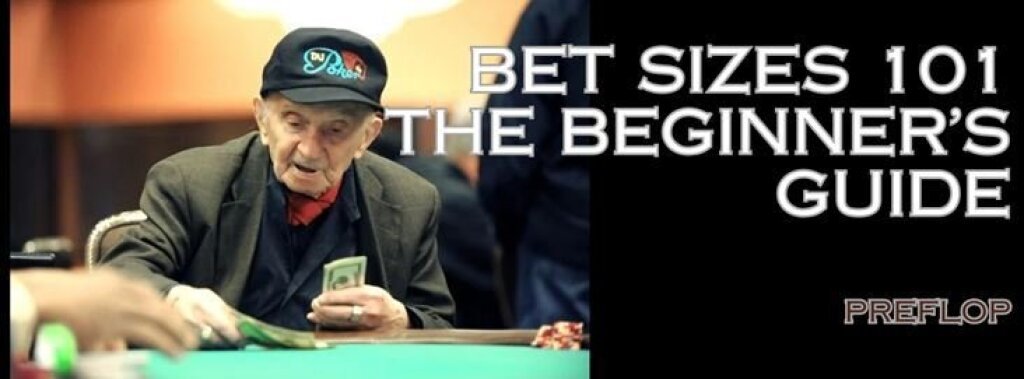Today, we'll summarize basic bet sizes for your preflop play. Please note that the following suggestions are simplifications. In order to understand something complex, like a theoretically optimal play, you need to chunk it into parts you can consume. This article aims not to give a widespread view of theory but to give a handful of tools to start your poker journey. If you are interested in the following articles, we'll dig deeper into bet sizes.
Now that we have clarified all this let's jump into preflop sizes for beginners.
Open size by position
This introductory article will establish some basic, somewhat simplified principles to help you start playing. First, we'll use small open sizes. The main reason is to invest the least possible money to steal the blinds. That's right, this game aims to win the blind bets. Without going into too much detail, these forced bets create the action in the game of Texas hold'em. The cheap risk-reward of "stealing" the blinds is also a solver-approved, theoretically correct approach.
There are two interesting factors. The more players are behind you to act, the less you want to invest. This is especially true for early positions. As you are close to the BTN or stay heads up as the SB, the odds are a bit changed, and the other factor is that the blinds have already been invested into the pot. Hence, they're more incentivized to continue; you might want to increase your opening sizes.
So, here is a beginner's table for opening sizes:
| Position | Size |
| UTG | 2bb |
| MP | 2bb |
| CO | 2bb |
| BTN | 2,5bb |
| SB | 3bb |
Don't forget there is a correlation between your opening ranges and bet sizes used. The bigger you open, the narrow range you can play, and the contrary is also true. Thus, preflop charts are useless without the information on open sizes.
Please note that there might be higher EV sizes (although preflop has the most negligible impact on winrate) and exploits, but we'll focus on a simplified beginner's strategy.
Isolation size
We are talking about the possibility of isolation when someone posts a blind' out of turn' or limps in. There are various scenarios in this rare situation; poker sites usually allow players to post a blind out-of-turn to get dealt immediately. Also, the action can be opened by only calling the big blind (limping). These scenarios often imply that the player who posts blind or limps in is a recreational player since it's a suboptimal strategy, losing EV and the possibility of immediately winning the pot. There is a third limping situation in blind versus blind play from the Small Blind. In certain circumstances, it's a viable and more complex strategy, but a low-rake environment is a must, which is not really a thing in low and small-stakes games.
There is a key factor when we discuss isolation sizes: the position. As you can see on other occasions, the in-position play allows us to use smaller sizes, and the out-of-position play requires larger sizes. That's mathematical; we try to compensate for our positional disadvantage by providing worse odds to call preflop. Therefore, we use a 3,5bb iso size in position and a 4,5bb iso out of position. In case another player overlimps, you should add another big blind per player to your isolation. For instance, CO open limps and BTN overlimps, and you have the option to iso-raise from the SB. Normally, you would use 4,5bb out of position, but now you'll add another big blind and isolate for 5,5bb in total.
Although the scope of this article doesn't include exploitative plays, keep in mind that the situation of isolation implies exploitation since, the majority of the time, you'll play against recreational players.
| Position | Size |
| In position | 3,5bb |
| Out of position | 4,5bb |
| In case of overlimps | +1bb/overlimp |
3-bet sizes
3-betting is possible when another player open raises (2-bets). When discussing 3-bet sizes, we need to distinguish positional differences and four distinct situations. You'll see that we tend to use smaller sizes in position; however, if we're out of position, we'll need larger sizes. There are classic in-position 3-bets (when EP-CO opens and we 3-bet from MP-BTN), out-of-position 3-bets (when EP-BTN opens and we 3-bet from SB or BB), a somewhat unique blind versus blind 3-bet (when SB opens and BB 3-bets) and last but not least the so-called squeeze opportunities (when a player opens, someone cold calls and a third player has the opportunity to 3-bet).
A fundamental basic principle is to avoid static sizes. Compared to the open sizes, where we usually use fixed sizes, in a 3-bet situation, there are more variables, namely that we can face different open sizes. To simplify, we would like to avoid investing unnecessarily significant amounts with our bluffs, and we don't want to give too good odds with our great hands. So, we need a ratio that serves each part of our range the most.
Let's go through each spot individually with examples for better understanding!
Starting with in-position 3-bets, usually, we choose somewhere around 3-3,5x to a' normal' 2-2,5bb open. This will give you a 3-bet size of around 6,5-8,5bb on average. With 100bb effective stacks, there will be plenty of room to play against 4-bets or even postflop for three streets, depending on the board texture.
As we mentioned, if you're out of position, you must increase your sizings to decrease the EV of calling. If you were using a 3x 3-bet size, you would provide such great odds to the opener that most of her range could continue. When discussing SB and BB 3-bets, we normally aim for a 4,5-5x size. Since you are implementing new strategies and sizes, we recommend simplifying as much as possible. Even though there might be slight EV differences since an SB and BB range differs drastically in shape, composition, and the inherent odds are also slightly different (as you invest the double from BB, at the same time, there is no third player left to act), postflop play will make a more significant impact on your winrate than an elegant sizing scheme preflop. Therefore, your average sizing will land somewhere between 9-13bb when 3-betting out of position.
Next, we need to discuss blind versus blind 3-bets, which are a bit special. We'll be in position from the BB, but ranges are also the widest from all the possible 3-betting spots. The BB's range also consists of many weak hands (polarized), so a huge sizing is not viable. Hence, we tend to use around a 3x sizing, answering to a standard open with a 9-10bb 3-bet.
Another specific spot is squeeze situations; when someone opens the action, and another player cold calls it, then a third player has the opportunity to 3-bet. Nowadays, it's relatively uncommon to cold call open raises from any other position than BB, but some strategies involve BTN cold calls as well. Most other cases will imply that the cold caller is a recreational or an inexperienced player. Whatever the reason, as the 3-bettor, you state that you have such a strong range that you can 3-bet against multiple players. Indeed, you'll need a tighter range to make such a move, but you'll also have to increase your 3-betting sizes.
Of course, you'll need to distinguish between in-position and out-of-position squeezes, but the first one will be rather rare, as highlighted above. The best advice is to use the formula of 3-bet size according to position plus add the cold callers' amount to your 3-bet. For instance, CO opens 2bb, the BTN calls it, and you decide to 3-bet from SB. Usually, you would go around 10bb (remember 4,5-5x?), but this time, you add another 2bb because of the cold caller, totalling a 12bb squeeze.
| Spot | Size |
| In position (MP-BTN) | 3-3,5x |
| In position (BvB) | 3x |
| Out of position (SB, BB) | 4,5-5x |
| Squeeze | normal size + cold call amount |
4-bet sizes
In today's article, last we'll discuss 4-bet sizes. Most beginners miss many 4-bet opportunities, so it's fair to say that low-stakes games lack 4-bets, making this spot very rare. Consequently, most players are unsure about ranges and sizes, as well. We intend to give some basics to start this journey of 4-betting. Again, we'll divide positionally how to approach your sizings; this way, you'll have some structure in your head.
At this point, you probably get used to the fact that in position, we tend to use smaller, and out of position, we elect to use bigger sizes. 4-bets are no exception, either. However, the complex possibility of 4-betting is widespread. We'll mention heads-up situations in and out of position and blind versus blind 4-bets but leave cold 4-bets and squeeze spots to the following advanced article.
4-bet sizes are similar to 3-bet sizes in the sense of using a constant multiplier rather than a fixed sizing for the same reasons.
4-betting in position: so you've already faced a larger 3-bet (due to the increase in 3-bet sizes OOP), there is no need nor room for going big with your 4-bets. We suggest around a 2,2x sizing, which forces the worst hands (light 3-bets) of your opponent to fold and at the same time, you invest the bare minimum with your bluffs, as well. Let's see an example: we open the BTN for 2,5bb, SB 3-bets to 11bb, and we choose to 4-bet to 24bb, a perfectly measured size and our opponent quickly folds.
We'll need to mitigate our positional disadvantage out of position, so we'll increase our 4-bets to 3x. This means that facing a 7-8bb 3-bet, we'll go around 21-24bb with our 4-bets, most likely in COvBTN positions, where 3-betting IP occurs the most often.
Blind versus blind, we'll also have an out-of-position 4-bet opportunity, but the circumstances are somewhat different. Ranges are extremely wide compared to other 3-bet spots. The composition we've already discussed and sizes are elevated due to the bigger (3bb) openings from the SB. This leads to the use of an in-between 4-bet size in this case. We suggest a 2,5x as a standard so that a betting pattern will look something like 3bbà9bbà23bb.
| Spot | Size |
| In position | 2,2x |
| Out of position (BvB) | 2,5x |
| Out of position (any other) | 3x |
You may have noticed that 4-bets reflect very similar sizes in bb; independently from the situation, it will land between 21-24bb on average.
Summary
Today, we went through the basic preflop bet sizes you'll need to go comfortably into your poker battles: open sizes, isolation, 3-bet and 4-bet sizes. As you can see, there are no one-size-fits-all answers. Our suggestion is to simplify your sizes at the beginning, and once you can use them confidently, check for more advanced information and nuances where you can increase the EV of your play. In your preflop opens, stick to the small sizes as they'll give you a better risk-reward ratio to steal the blinds (2-3bb). Always be positionally aware and use smaller sizes in position and larger ones out of position, from isolations to 3-bets & 4-bets. Always use a multiplier with the latter two instead of a fixed number of big blinds. Study and memorize the given charts; it's crucial not to waste time figuring out such basic acts as choosing your preflop bet sizes.
If you are interested in more about preflop sizes, exploits and different stack depths, stay tuned for the following articles.

















0 comments